Workstation Graphics: AGP Cross Section 2004
by Derek Wilson on December 23, 2004 4:14 PM EST- Posted in
- GPUs
SPECViewperf 8.0.1 Performance
For our SPECviewperf tests, we will look at graphs of the overall weighted scores for each viewset. We have also listed the scores for the individual tests for each viewset. For each section, we will begin by listing the description of the viewset from the SPEC website, and then analysing the data.For futher details on how SPECviewperf scores are compiled, please see the SPEC website.
All cards were set to their default professional graphics settings, whatever those happened to be, before running SPECviewperf.
3dsmax Viewset (3dsmax-03)
"The 3dsmax-03 viewset was created from traces of the graphics workload generated by 3ds max 3.1. To ensure a common comparison point, the OpenGL plug-in driver from Discreet was used during tracing.The Wildcat Realizm 200 leads in this benchmark, followed by the Quadro FX 4000. This is quite interesting, since by street price, the Realizm is the cheapest card that we have in the bunch. ATI's MSRP is lower than the 3Dlabs part, but value is all in purchasing power and performance.
The models for this viewset came from the SPECapc 3ds max 3.1 benchmark. Each model was measured with two different lighting models to reflect a range of potential 3ds max users. The high-complexity model uses five to seven positional lights as defined by the SPECapc benchmark and reflects how a high-end user would work with 3ds max. The medium-complexity lighting models use two positional lights, a more common lighting environment.
The viewset is based on a trace of the running application and includes all the state changes found during normal 3ds max operation. Immediate-mode OpenGL calls are used to transfer data to the graphics subsystem."
The DCC side of the workstation market isn't as large as CAD/CAM, but 3DStudio is still an important application. Of course, this viewset tests straight OpenGL performance, and each of these workstation cards have a custom driver for 3DStudio Max, which we will test in the SEPCapc portion of our benchmark suite.

| SPECviewperf 8.0.1 3dsmax-03 | ||||||||||||||
| 1 | 2 | 3 | 4 | 5 | 6 | 7 | 8 | 9 | 10 | 11 | 12 | 13 | 14 | |
| Quadro FX 4000 | 38.6 | 38.5 | 21.8 | 18.8 | 75 | 53.7 | 40.6 | 30.6 | 17.2 | 70.3 | 25.3 | 26.2 | 21 | 20.1 |
| Wildcat Realizm 200 | 38.6 | 38 | 30.2 | 24.3 | 74.1 | 62.1 | 43.5 | 40.4 | 28.3 | 68.7 | 24.1 | 24.1 | 18.3 | 18.3 |
| FireGL X3-256 | 32.2 | 27.3 | 23.4 | 18.5 | 62.8 | 51 | 28.9 | 31.9 | 18.6 | 66.6 | 20.5 | 20.6 | 16 | 16.1 |
| GeForce 6800 U GC | 17.5 | 15.9 | 14.8 | 14.7 | 42.4 | 29.2 | 27.1 | 19.1 | 14.9 | 40.8 | 14.2 | 14.1 | 11.5 | 11.2 |
| Radeon X800 XTPE | 12 | 8.09 | 12.5 | 10.7 | 35.9 | 23.6 | 11.6 | 15.8 | 10 | 32.7 | 11.4 | 6.37 | 9.3 | 7.86 |
CATIA Viewset (catia-01)
"The catia-01 viewset was created from traces of the graphics workload generated by the CATIATM V5R12 application from Dassault Systemes.The state change information found in the CATIA is a big part of the improvement in SPECviewperf 8. The nature of OpenGL as a state machine is the major advantage of the API in workstation applications. The viewing and manipulation of state are key elements in workstation graphics today. Taking a look at performance here, we see the Quadro FX 4000 taking the lead on this one followed by the Realizm 200.
Three models are measured using various modes in CATIA. Phil Harris of LionHeart Solutions, developer of CATBench2003, supplied SPEC/GPC with the models used to measure the CATIA application. The models are courtesy of CATBench2003 and CATIA Community.
The car model contains more than two million points. SPECviewperf replicates the geometry represented by the smaller engine block and submarine models to increase complexity and decrease frame rates. After replication, these models contain 1.2 million vertices (engine block) and 1.8 million vertices (submarine).
State changes as made by the application are included throughout the rendering of the model, including matrix, material, light and line-stipple changes. All state changes are derived from a trace of the running application. The state changes put considerably more stress on graphics subsystems than the simple geometry dumps found in older SPECviewperf viewsets.
Mirroring the application, draw arrays are used for some tests and immediate mode used for others."
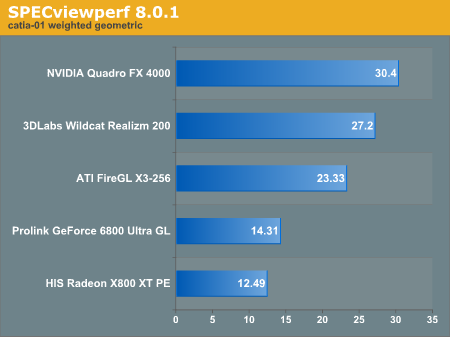
| SPECviewperf 8.0.1 catia-01 | |||||||||||
| 1 | 2 | 3 | 4 | 5 | 6 | 7 | 8 | 9 | 10 | 11 | |
| Quadro FX 4000 | 48.9 | 37.2 | 26.9 | 27.9 | 19 | 47.8 | 29.6 | 28.9 | 19 | 23.2 | 46.1 |
| Wildcat Realizm 200 | 52.1 | 38.6 | 15.8 | 29.7 | 18.9 | 63.3 | 32.5 | 27.6 | 22 | 20.6 | 13.7 |
| FireGL X3-256 | 39.7 | 25.8 | 19.1 | 22.8 | 16.2 | 34 | 25.2 | 18.8 | 15 | 19.1 | 34.8 |
| GeForce 6800 U GC | 20.2 | 22.5 | 11.5 | 12.6 | 8.9 | 31.1 | 17.2 | 4.49 | 11.2 | 12.7 | 27.2 |
| Radeon X800 XTPE | 20.9 | 10.3 | 10.9 | 11.7 | 7.38 | 26.7 | 13.1 | 12.5 | 8.86 | 7.41 | 21 |
EnSight (ensight-01)
"The ensight-01 viewset replaces the Data Explorer (dx) viewset. It represents engineering and scientific visualization workloads created from traces of CEI's EnSight application.This time around, we see the FireGL X3-256 jump to the head of the pack. Even though the X3-256 has trailed in the previous tests, it has managed to clearly lead the EnSight performance tests.
CEI contributed the models and suggested workloads. Various modes of the EnSight application are tested using both display-list and immediate-mode paths through the OpenGL API. The model data is replicated by SPECviewperf 8.0 to generate 3.2 million vertices per frame.
State changes as made by the application are included throughout the rendering of the model, including matrix, material, light and line-stipple changes. All state changes are derived from a trace of the running application. The state changes put considerably more stress on graphics subsystems than the simple geometry dumps found in older viewsets.
Mirroring the application, both immediate-mode and display-list modes are measured."

Six out of the nine tests are led by the FireGL X3. Interestingly, in tests 5, 6, and 8, the Realizm 200 leads both the FireGL X3-256 and the Quadro FX 4000. Test 1 has a weight of 12, while the following 8 tests have a weight of 11 each.
| SPECviewperf 8.0.1 ensight-01 | |||||||||
| 1 | 2 | 3 | 4 | 5 | 6 | 7 | 8 | 9 | |
| Quadro FX 4000 | 42.7 | 35.4 | 35.6 | 31.1 | 13.7 | 13.6 | 31 | 13.8 | 31 |
| Wildcat Realizm 200 | 24.5 | 20.9 | 26.7 | 23 | 16 | 15.9 | 23 | 16 | 23 |
| FireGL X3-256 | 53.6 | 50 | 53.7 | 44.6 | 12.3 | 12.3 | 44.7 | 12.3 | 44.6 |
| GeForce 6800 U GC | 11.6 | 3.98 | 39.3 | 34.1 | 7.22 | 7.23 | 34 | 7.26 | 34 |
| Radeon X800 XTPE | 14.1 | 54.4 | 45.5 | 34.8 | 5.84 | 5.78 | 34.8 | 5.8 | 34.8 |
Lightscape Viewset (light-07)
"The light-07 viewset was created from traces of the graphics workload generated by the Lightscape Visualization System from Discreet Logic. Lightscape combines proprietary radiosity algorithms with a physically-based lighting interface.The Quadro FX 4000 outpeforms the Wildcat Realizm by about 3.4% in the lighscape test. This time, the FireGL X3-256 is back where we would expect based on ATI's positioning of the product.
The most significant feature of Lightscape is its ability to accurately simulate global illumination effects by pre-calculating the diffuse energy distribution in an environment and storing the lighting distribution as part of the 3D model. The resulting lighting "mesh" can then be rapidly displayed."
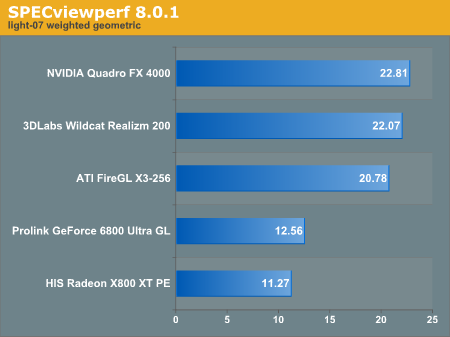
| SPECviewperf 8.0.1 light-07 | |||||
| 1 | 2 | 3 | 4 | 5 | |
| Quadro FX 4000 | 23.7 | 37.5 | 18.1 | 13.8 | 27.8 |
| Wildcat Realizm 200 | 25.4 | 44.3 | 14.1 | 12.8 | 25.8 |
| FireGL X3-256 | 24.8 | 44.5 | 12.5 | 11.6 | 24.2 |
| GeForce 6800 U GC | 13.2 | 24.2 | 9.06 | 6.75 | 16 |
| Radeon X800 XTPE | 12.1 | 22.6 | 7.96 | 5.89 | 14.2 |
Maya Viewset (maya-01)
"The maya-01 viewset was created from traces of the graphics workload generated by the Maya V5 application from Alias.The clear leader in this test is the Quadro FX 4000. The NVIDIA part leads every test under Maya by a large margin. The differences between each card are very large all the way down to the X800 XT PE.
The models used in the tests were contributed by artists at NVIDIA. Various modes in the Maya application are measured.
State changes as made by the application are included throughout the rendering of the model, including matrix, material, light and line-stipple changes. All state changes are derived from a trace of the running application. The state changes put considerably more stress on graphics subsystems than the simple geometry dumps found in older viewsets.
As in the Maya V5 application, array element is used to transfer data through the OpenGL API."
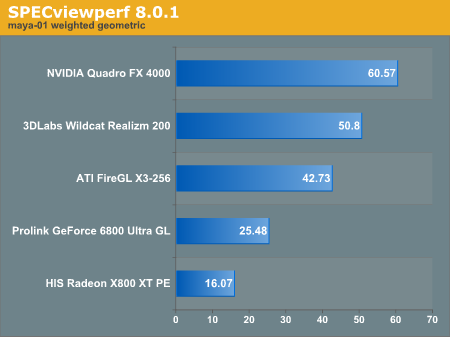
| SPECviewperf 8.0.1 maya-01 | |||||||||
| 1 | 2 | 3 | 4 | 5 | 6 | 7 | 8 | 9 | |
| Quadro FX 4000 | 152 | 52.5 | 37.2 | 42.6 | 27.6 | 100 | 82.3 | 82.7 | 49.6 |
| Wildcat Realizm 200 | 126 | 41.1 | 30.8 | 33.3 | 17.7 | 96.3 | 79.8 | 76.8 | 44.7 |
| FireGL X3-256 | 110 | 33.3 | 23.2 | 29.2 | 20.6 | 82 | 51.1 | 63.7 | 37.2 |
| GeForce 6800 U GC | 54 | 24.5 | 16 | 12.8 | 10 | 52 | 39.5 | 37.4 | 23.7 |
| Radeon X800 XTPE | 25.2 | 14.9 | 9.02 | 8.03 | 7.2 | 36.1 | 26.7 | 25 | 16.3 |
Pro/ENGINEER (proe-03)
"The proe-03 viewset was created from traces of the graphics workload generated by the Pro/ENGINEER 2001TM application from PTC.This is an absolutely huge test in terms of data and workload placed on the cards. The Quadro FX 4000 leads here, but the 3 workstation cards really are close and excel in different areas. Check out the table and see what we mean.
Two models and three rendering modes are measured during the test. PTC contributed the models to SPEC for use in measurement of the Pro/ENGINEER application. The first of the models, the PTC World Car, represents a large-model workload composed of 3.9 to 5.9 million vertices. This model is measured in shaded, hidden-line removal, and wireframe modes. The wireframe workloads are measured both in normal and antialiased mode. The second model is a copier. It is a medium-sized model made up of 485,000 to 1.6 million vertices. Shaded and hidden-line-removal modes were measured for this model.
This viewset includes state changes as made by the application throughout the rendering of the model, including matrix, material, light and line-stipple changes. The PTC World Car shaded frames include more than 100MB of state and vertex information per frame. All state changes are derived from a trace of the running application. The state changes put considerably more stress on graphics subsystems than the simple geometry dumps found in older viewsets.
Mirroring the application, draw arrays are used for the shaded tests and immediate mode is used for the wireframe. The gradient background used by the Pro/E application is also included to model the application workload better."
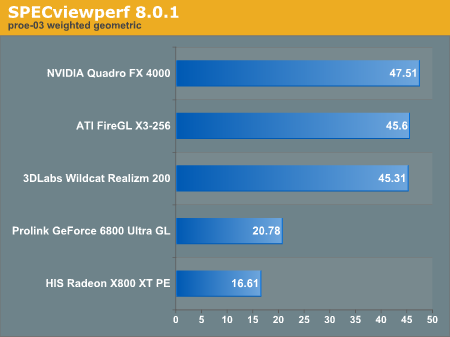
Tests 1, 2 and 3 are clearly led by the FireGL X3-256. Unfortunately for ATI, the rest of the tests fall very short. The Wildcat Realizm 200 is much closer to the Quadro FX 4000 than it appears in the overall result. It leads 3 out of 7 benchmarks and is close in two of its losses. Test number 6 really pushes the Quadro up in score. It is data like this that gets lost in geometric means sometimes.
| SPECviewperf 8.0.1 proe-03 | |||||||
| 1 | 2 | 3 | 4 | 5 | 6 | 7 | |
| Quadro FX 4000 | 26.6 | 31 | 24.9 | 53.4 | 53.2 | 170 | 52.6 |
| Wildcat Realizm 200 | 27.1 | 31.8 | 24.5 | 54.2 | 45.2 | 143 | 51.3 |
| FireGL X3-256 | 38.3 | 45.9 | 31.7 | 38.4 | 36 | 135 | 42.9 |
| GeForce 6800 U GC | 11.2 | 13.1 | 15.3 | 33.5 | 8.55 | 88.5 | 32.7 |
| Radeon X800 XTPE | 7.33 | 8.63 | 9.05 | 22.7 | 22.5 | 44.2 | 23.8 |
SolidWorks Viewset (sw-01)
"The sw-01 viewset was created from traces of the graphics workload generated by the Solidworks 2004 application from Dassault Systemes.The Realizm 200 comes out on top again in this benchmark, followed by the Quadro FX 4000, with the ATI card bringing up the rear. Here, we see a situation similar to the proe test when we look at the table of data.
The model and workloads used were contributed by Solidworks as part of the SPECapc for SolidWorks 2004 benchmark.
State changes as made by the application are included throughout the rendering of the model, including matrix, material, light and line-stipple changes. All state changes are derived from a trace of the running application. The state changes put considerably more stress on graphics subsystems than the simple geometry dumps found in older viewsets.
Mirroring the application, draw arrays are used for some tests and immediate mode used for others."
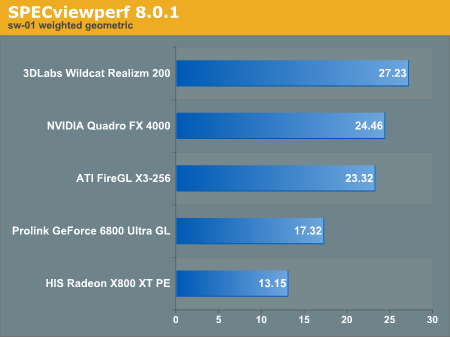
The Quadro FX 4000 leads in tests 2, 3, and 4. Test 7 is really what causes the major dichotomy in scoring between the two parts in the overall test. The Wildcat Realizm 200 is still the better part for the job under the SolidWords viewset, but it's good to step back and take a look at the individual test data.
| SPECviewperf 8.0.1 sw-01 | ||||||||
| 1 | 2 | 3 | 4 | 5 | 6 | 7 | 8 | |
| Quadro FX 4000 | 34.4 | 12.4 | 14.2 | 17.2 | 40.5 | 28.9 | 49.3 | 21.3 |
| Wildcat Realizm 200 | 43.4 | 9.76 | 12.6 | 15.5 | 48 | 32.7 | 103 | 22.6 |
| FireGL X3-256 | 26.6 | 12.1 | 15.3 | 18.5 | 39.5 | 25.5 | 52.4 | 18.2 |
| GeForce 6800 U GC | 31.8 | 10.6 | 10.6 | 13.8 | 32.8 | 12.2 | 33.4 | 12.3 |
| Radeon X800 XTPE | 23.7 | 6.04 | 6.37 | 8.04 | 18.3 | 11.5 | 52.1 | 11.1 |
Unigraphics (ugs-04)
"The ugs-04 viewset was created from traces of the graphics workload generated by Unigraphics V17.The NVIDIA workstation solution is much better able to handle this workload. The huge models with shaded with transparencies turned on are easily rendered on the Quadro FX 4000.
The engine model used was taken from the SPECapc for Unigraphics V17 application benchmark. Three rendering modes are measured: shaded, shaded with transparency, and wireframe. The wireframe workloads are measured both in normal and anti-alised mode. All tests are repeated twice, rotating once in the center of the screen and then moving about the frame to measure clipping performance.
The viewset is based on a trace of the running application and includes all the state changes found during normal Unigraphics operation. As with the application, OpenGL display lists are used to transfer data to the graphics subsystem. Thousands of display lists of varying sizes go into generating each frame of the model.
To increase model size and complexity, SPECviewperf 8.0 replicates the model two times more than the previous ugs-03 test."
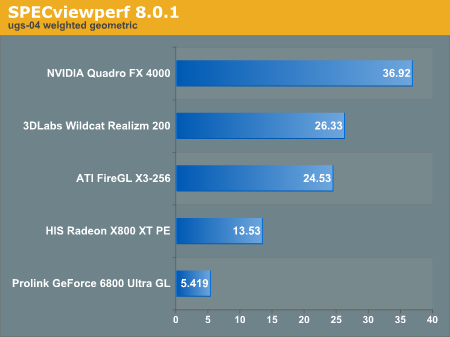
| SPECviewperf 8.0.1 ugs-04 | ||||||||
| 1 | 2 | 3 | 4 | 5 | 6 | 7 | 8 | |
| Quadro FX 4000 | 30.1 | 34.7 | 27.8 | 31.2 | 51 | 62.2 | 47.5 | 49.8 |
| Wildcat Realizm 200 | 24.3 | 26.8 | 22 | 23.2 | 38.8 | 31.4 | 30.2 | 26.7 |
| FireGL X3-256 | 18.5 | 19.1 | 13.9 | 14.4 | 53.4 | 56.4 | 53.7 | 53.3 |
| GeForce 6800 U GC | 3.29 | 3.86 | 3.01 | 3.52 | 27.3 | 31.9 | 4.94 | 7.38 |
| Radeon X800 XTPE | 11.9 | 12 | 9.13 | 9.13 | 22.2 | 22.6 | 22.2 | 22.4 |
To sum up SPECviewperf 8.0.1 Performance, we have the FireGL X3-256 Leading 1 benchmark (ensight), the Wildcat Realism 200 leading 2 benchmarks (3dsmax, sw), and the Quadro FX 4000 taking pole position on the other 5 tests.
Now, let's put the cards to the test inside applications and see if performance holds up.










25 Comments
View All Comments
Sword - Friday, December 24, 2004 - link
Hi again,I want to add to my first post that there were 2 parts and a complex assembly (>110 very complex parts without simplified rep).
The amount of data to process was pretty high (XP shows >400 Mb and it can goes up to 600 Mb).
About the specific features, I believe that most of the CAD users do not use them. People like me, mechanical engineers and other engineers, are using the software like Pro/E, UGS, Solidworks, Inventor and Catia for solid modeling without any textures or special effects.
My comment was really to point that the high end features seams useless in real world application for engineering.
I still believe that for 3D multimedia content, there is place for high-end workstation and the specviewperf benchmark is a good tool for that.
Dubb - Friday, December 24, 2004 - link
how about throwing in soft-quadro'd cards? when people realize with a little effort they can take a $350 6800GT to near-q4000 performance, that changes the pricing issue a bit.Slaimus - Friday, December 24, 2004 - link
If the Realizm 200 performs this well, it will be scary to see the 800 in action.DerekWilson - Friday, December 24, 2004 - link
dvinnen, workstation cards are higher margin -- selling consumer parts may be higher volume, but the competition is harder as well. Creative would have to really change their business model if they wanted to sell consumer parts.Sword, like we mentioned, the size of the data set tested has a large impact on performance in our tests. Also, Draven31 is correct -- a lot depends on the specific features that you end up using during your normal work day.
Draven31, 3dlabs drivers have improved greatly with the Realizm from what we've seen in the past. In fact, the Realizm does a much better job of video overlay playback as well.
Since one feature of the Quadro and Realizm cards is their ability to run genlock/framelock video walls, perhaps a video playback/editing test would make a good addition to our benchmark suite
Draven31 - Friday, December 24, 2004 - link
Coming up with the difference between the spec viewperf tests and real-world 3d work means finding out which "high-end card' features that the test is using and then turning them off in the tests. With NVidia cards, this usually starts with antialiased lines. It also depends on whether the application you are running even uses these features... in Lightwave3D, the 'pro' cards and the consumer cards are very comparable performance-wise because it doesn't use these so-called 'high-end' features very extensively.And while they may be faster in some Viewperf tests, 3dLabs drivers generally suck. Having owned and/or used several, I can tell you any app that uses DirectX overlays as part of its display routines is going to either be slow or not work at all. For actual application use, 3dLabs cards are useless. I've seen 3dLabs cards choke on directX apps, and that includes both games and applications that do windowed video playback on the desktop (for instance, video editing and compositing apps)
Sword - Thursday, December 23, 2004 - link
Hi everyone,I am a mechanical engineer in Canada and I am a fan of anandtech.
I made last year a very big comparison of mainstream vs workstation video card for our internal use (the company I work for).
The goal was to compare the different systems (and mainly video cards) to see if in Pro-Engineer and the kind of work with do we could take real advantage of high-end workstation video card.
My conclusion is very clear : in specviewperf there is a huge difference between mainstream video card and workstation video card. BUT, in the day-to-day work, there is no real difference in our reaults.
To summarize, I made a benchmark in Pro/E using the trail files with 3 of our most complex parts. I made comparison in shading, wireframe, hidden line and I also verified the regeneration time for each part. The benchmark was almost 1 hour long. I compared 3D Labs product, ATI professionnal, Nvidia professionnal and Nvidia mainstream.
My point is : do not believe specviewperf !! Make your own comparison with your actual day-to-day work to see if you really have to spend 1000 $ per video cards. Also, take the time to choose the right components so you minimize the calculation time.
If anyone at Anandtech is willing to take a look at my study, I am willing to share the results.
Thank you
dvinnen - Thursday, December 23, 2004 - link
I always wondered why Creative (they own 3dLabs) never made a consumer edition of the Wildcat. Seems like a smallish market when it wouldn't be all that hard to expand into consumer cards.Cygni - Thursday, December 23, 2004 - link
Im surprised by the power of the Wildcat, really... great for the dollar.DerekWilson - Thursday, December 23, 2004 - link
mattsaccount,glad we could help out with that :-)
there have been some reports of people getting consumer level driver to install on workstatoin class parts, which should give better performance numbers for the ATI and NVIDIA parts under games if possible. But keep in mind that the trend in workstation parts is to clock them at lower speeds than the current highest end consumer level products for heat and stability reasons.
if you're a gamer who's insane about performance, you'd be much better off paying $800 on ebay for the ultra rare uberclocked parts from ATI and NVIDIA than going out and getting a workstation class card.
Now, if you're a programmer, having access to the workstation level features is fun and interesting. But probably not worth the money in most cases.
Only people who want workstation class features should buy workstation class cards.
Derek Wilson
mattsaccount - Thursday, December 23, 2004 - link
Yes, very interesting. This gives me and lots of others something to point to when someone asks why they shouldn't get the multi-thousand dollar video card if they want top gaming performance :)